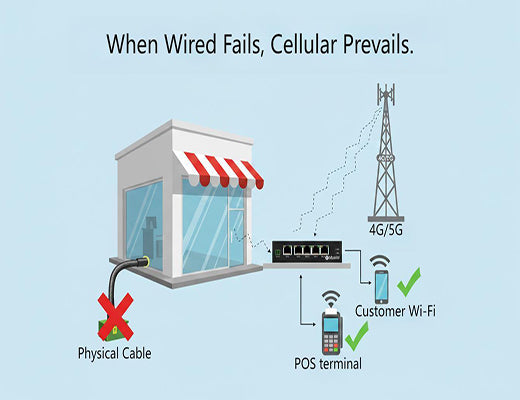
What is WAN Failover? A Guide to Unbreakable Internet Connectivity
|
|
Time to read 5 min
|
|
Time to read 5 min
What is WAN failover? In short, it's a critical technology that serves as an automated "Plan B" for your business's internet. It works by having a specialized router automatically switch your network's traffic from a primary wired connection (like fiber or cable) to a secondary backup connection (like 4G/5G cellular) the moment an outage is detected. This ensures true business continuity, turning potentially catastrophic internet downtime into a minor, background non-event.
WAN failover is an automated function in a router that provides a backup internet connection to keep your business online.
Using a cellular 4G/5G connection as the backup is the most effective strategy because it provides true "path diversity," making it immune to local physical cable cuts.
A professional internet backup solution can switch connections in under 30 seconds and is fast enough to run an entire branch office, including POS terminals and cloud applications.
For any business that relies on the internet, it's a low-cost insurance policy against the massive financial losses caused by downtime.
I was at a busy coffee shop last week, and their internet went down right during the morning rush. The line of caffeine-deprived customers ground to a halt. The staff couldn't process any credit card payments. They had to frantically wave people away to a competitor across the street. I could almost see the dollar bills flying out the window.
Let's be clear: for any modern retail business, your internet connection is your cash register. When it goes down, you are closed for business.
The crazy part? This entire crisis is completely preventable. For a small investment, a simple cellular backup solution can make internet outages a complete non-event. This guide will show you exactly how this strategy, called WAN failover, works.

At its heart, WAN failover is an automated process managed by a specialized router, often called a dual-WAN router.
The entire process is automatic. For the people using the network, the transition is often completely imperceptible.
Getting a new wired business internet line installed can take weeks. A cellular internet backup solution can be deployed in minutes.

When you're ready to implement this strategy, look for a router that offers these critical features.

This isn't just theory. A national financial institution implemented a Robustel 5G WAN failover solution across its 500 branch locations. The results were transformative:
99.99% network uptime across all branch locations.
$2.5 million in potential revenue loss annually.
less than 30 seconds.
In a world where internet connectivity is the lifeblood of business, WAN failover is no longer a luxury for big enterprises; it's an accessible and essential strategy for any business that depends on the internet.
By using a professional industrial router to combine a primary wired connection with a secondary cellular backup, you are purchasing the most valuable insurance policy available: the guarantee of business continuity.
Learn more in our main guide:
A1: It's nearly instant. A professional router can typically detect an outage and switch over to the cellular backup in under 30 seconds. For most applications and users, this transition is seamless and unnoticeable.
A2: It's surprisingly affordable. The cellular data is only consumed during an actual outage. Given that M2M/IoT data plans are very competitive, the monthly cost is minimal compared to the cost of even a few minutes of lost business during an outage.
A3: This is a great question.
WAN failover switches between different types of internet connections (e.g., wired Fiber to wireless Cellular).
Dual-SIM failover switches between two different cellular carriers on the same device. A highly resilient setup will actually use both: a primary wired connection that fails over to a router with two SIM cards for ultimate redundancy.